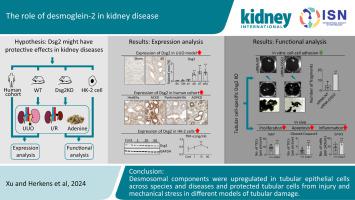当前位置:
X-MOL 学术
›
Kidney Int.
›
论文详情
Our official English website, www.x-mol.net, welcomes your feedback! (Note: you will need to create a separate account there.)
The role of desmoglein-2 in kidney disease
Kidney International ( IF 19.6 ) Pub Date : 2024-02-21 , DOI: 10.1016/j.kint.2024.01.037 Tong Xu , Lea Herkens , Ting Jia , Barbara M. Klinkhammer , Sebastian Kant , Claudia A. Krusche , Eva M. Buhl , Sikander Hayat , Jürgen Floege , Pavel Strnad , Rafael Kramann , Sonja Djudjaj , Peter Boor
Kidney International ( IF 19.6 ) Pub Date : 2024-02-21 , DOI: 10.1016/j.kint.2024.01.037 Tong Xu , Lea Herkens , Ting Jia , Barbara M. Klinkhammer , Sebastian Kant , Claudia A. Krusche , Eva M. Buhl , Sikander Hayat , Jürgen Floege , Pavel Strnad , Rafael Kramann , Sonja Djudjaj , Peter Boor

|
Desmosomes are multi-protein cell-cell adhesion structures supporting cell stability and mechanical stress resilience of tissues, best described in skin and heart. The kidney is exposed to various mechanical stimuli and stress, yet little is known about kidney desmosomes. In healthy kidneys, we found desmosomal proteins located at the apical-junctional complex in tubular epithelial cells. In four different animal models and patient biopsies with various kidney diseases, desmosomal components were significantly upregulated and partly miss-localized outside of the apical-junctional complexes along the whole lateral tubular epithelial cell membrane. The most upregulated component was desmoglein-2 (Dsg2). Mice with constitutive tubular epithelial cell-specific deletion of developed normally, and other desmosomal components were not altered in these mice. When challenged with different types of tubular epithelial cell injury (unilateral ureteral obstruction, ischemia-reperfusion, and 2,8-dihydroxyadenine crystal nephropathy), we found increased tubular epithelial cell apoptosis, proliferation, tubular atrophy, and inflammation compared to wild-type mice in all models and time points. , silencing via siRNA weakened cell-cell adhesion in HK-2 cells and increased cell death. Thus, our data show a prominent upregulation of desmosomal components in tubular cells across species and diseases and suggest a protective role of Dsg2 against various injurious stimuli.
中文翻译:

desmoglein-2 在肾脏疾病中的作用
桥粒是多蛋白细胞间粘附结构,支持细胞稳定性和组织的机械应力恢复能力,在皮肤和心脏中得到了最好的描述。肾脏暴露于各种机械刺激和压力下,但人们对肾桥粒知之甚少。在健康的肾脏中,我们发现桥粒蛋白位于肾小管上皮细胞的顶端连接复合体处。在四种不同的动物模型和患有各种肾脏疾病的患者活检中,桥粒成分显着上调,并且沿着整个侧肾小管上皮细胞膜部分错误定位在顶端连接复合体之外。上调最多的成分是桥粒芯糖蛋白-2 (Dsg2)。具有组成性肾小管上皮细胞特异性缺失的小鼠发育正常,并且这些小鼠的其他桥粒成分没有改变。当遭受不同类型的肾小管上皮细胞损伤(单侧输尿管梗阻、缺血再灌注和2,8-二羟基腺嘌呤晶体肾病)时,我们发现与野生型小鼠相比,肾小管上皮细胞凋亡、增殖、肾小管萎缩和炎症增加在所有模型和时间点。 ,通过 siRNA 沉默削弱了 HK-2 细胞中的细胞间粘附并增加了细胞死亡。因此,我们的数据显示跨物种和疾病的肾小管细胞中桥粒成分的显着上调,并表明 Dsg2 对各种有害刺激的保护作用。
更新日期:2024-02-21
中文翻译:

desmoglein-2 在肾脏疾病中的作用
桥粒是多蛋白细胞间粘附结构,支持细胞稳定性和组织的机械应力恢复能力,在皮肤和心脏中得到了最好的描述。肾脏暴露于各种机械刺激和压力下,但人们对肾桥粒知之甚少。在健康的肾脏中,我们发现桥粒蛋白位于肾小管上皮细胞的顶端连接复合体处。在四种不同的动物模型和患有各种肾脏疾病的患者活检中,桥粒成分显着上调,并且沿着整个侧肾小管上皮细胞膜部分错误定位在顶端连接复合体之外。上调最多的成分是桥粒芯糖蛋白-2 (Dsg2)。具有组成性肾小管上皮细胞特异性缺失的小鼠发育正常,并且这些小鼠的其他桥粒成分没有改变。当遭受不同类型的肾小管上皮细胞损伤(单侧输尿管梗阻、缺血再灌注和2,8-二羟基腺嘌呤晶体肾病)时,我们发现与野生型小鼠相比,肾小管上皮细胞凋亡、增殖、肾小管萎缩和炎症增加在所有模型和时间点。 ,通过 siRNA 沉默削弱了 HK-2 细胞中的细胞间粘附并增加了细胞死亡。因此,我们的数据显示跨物种和疾病的肾小管细胞中桥粒成分的显着上调,并表明 Dsg2 对各种有害刺激的保护作用。



























 京公网安备 11010802027423号
京公网安备 11010802027423号